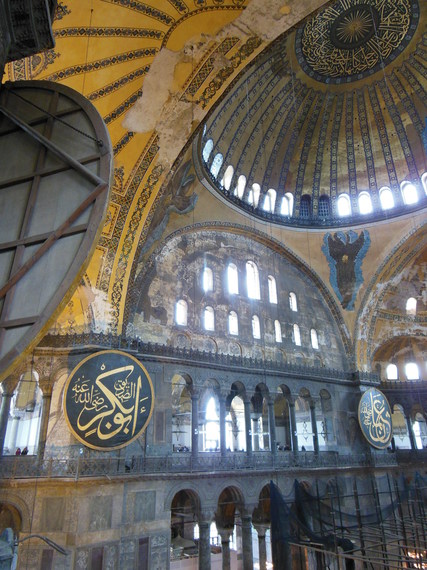The Hagia Sophia in Istanbul is an epic construct for the millennia, currently trapped in the miserable role of museum. This UNESCO World Heritage Site was inaugurated as a church in 537, converted to a mosque in 1453, and then secularized and opened as a museum in 1935. A building that was intended to be a center for worship, and was used as such for 1,400 years, now languishes on a hilltop overlooking the Bosphorus.
To paraphrase architect Louis Sullivan, form does not follow function at the Hagia Sophia. The museum lacks energy. It is devoid of spirit. In its current incarnation, the Hagia Sophia is an architectural failure.
That was not the impression I expected this monument to make before I visited Istanbul this past January. Since I have both undergraduate and graduate degrees in architecture, visiting the Hagia Sophia is practically a vocational rite of passage. From my studies of the building - which included a three-hour lecture on the construction of its famous dome - I was expecting my visit to be nothing short of a spiritually transformative event. I guess I got my hopes up too high.
Wandering through the Hagia Sophia was, no doubt, fascinating. It's hard to imagine that the building was constructed in less than six years. The interior space is cavernous, with the diameter of the dome spanning 102 feet. The mosaics are spectacular. Between the dome, the half-domes, the tympana, the colonnades and balustrades and galleries and ramps, I felt like I was walking through a holographic encyclopedia of architectural elements.
Then there was the scaffolding. A lot of it. No one was on it, but it covered one entire side of the building and obstructed a clear view of the dome. I guess scaffolding is to be expected in a building that's almost 1,500 years old. That was also the explanation I gave myself for the condition of some of the mosaics, which are being refurbished. Ditto for the peeling paint and cracks found throughout the building. Despite the funding provided through UNESCO and other sources, the building looked run-down, bordering on disrepair.
More jarring, however, was the attempt to "mosque-ify" the Hagia Sophia by attaching massive calligraphy panels onto the piers of the building. The panels contain the names of Allah, the prophet Muhammad, and other prominent figures of Islam. The panels themselves are beautiful but are completely out of scale with the rest of the building. Worse yet, they are clumsily attached. With a well-placed jab from the gallery, one of the panels could seemingly snap right off. Next to the detailed, colorful mosaics that depict Jesus, Mary, and other Christian figures, the iconography and scale of these panels create clashing visual dissonance. I couldn't tell if I was supposed to be in a church or a mosque.
That distinction matters because Christianity and Islam each have specific rituals, imagery and customs. Familiarity with these aspects of a religion can instantly create feelings of comfort and solemn reverence with respect to one's environs. Since today's Hagia Sophia suggests a house of multiple faiths, many visitors may feel confused, subconsciously or not, about their relationship with the building.
The Hagia Sophia can be re-energized very simply: it can be brought back to life as a place of worship. Discussion about this possibility has been underway for some time. On one hand, a faction of the Turkish government would like to re-open the building as a mosque. Given the recent victories in local elections by Prime Minister Recep Tayyip Erdogan's A.K.P. political party, this possibility may have strong support from many in the Turkish community.
Some Christians, however, have adamantly opposed the idea. In the words of today's Ecumenical Patriarch Bartholomew I, ''The Hagia Sophia basilica was built as a testament to Christian faith and if it is to be returned to a cult, it cannot be to any other than the Christian one." There's even a "Say NO to converting Hagia Sophia into a mosque" online petition. To date, it has almost 27,000 signatures.
Yet converting the Hagia Sophia into either a church or a mosque would provide the structure with the healthful vitality it lacks today. Critically, it would open up access to motivated sources of funding that could ensure the landmark's well-being for future generations.
From an architectural perspective, the Hagia Sophia can function in either incarnation -- as a church or as a mosque. The dome is a non-denominational feature used consistently in religious buildings to symbolically represent the heavens. If the Hagia Sophia were to become a basilica once more, there might be concern related to the minarets outside the building. The calligraphy panels and other script inside would also likely need to be removed or remediated. Re-converting the Hagia Sophia to a mosque would require careful consideration with regard to the display of the mosaics. The Christian figures could remain visible, or they could be temporarily covered during prayer time.
Christians can claim provenance of the Hagia Sophia. UNESCO can claim cultural authority. But since possession is nine-tenths of the law, the predominantly Muslim Turks can claim control. In a country that is 99 percent Muslim, the Hagia Sophia would generate the most utility if it were to become a mosque.
Therefore, I hope that the next time I visit the Hagia Sophia, I will have to remove my shoes and cover my head. I hope to visit the Hagia Sophia mosque right after prayer time so I can feel the energy of the faithful, right down to the foundation of the building.
